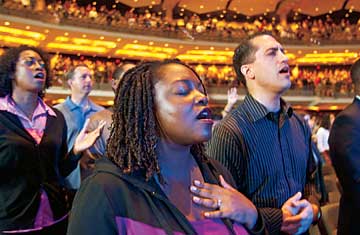
At Willow Creek, people of different ethnicities worship together
(4 of 5)
There were also larger race-oriented seminars and reconciliation-themed book clubs. Bibbs founded an annual "Justice Journey," busing Willow staff and black Chicago pastors together to bloodstained civil rights pilgrimage sites. Hybels added black, Hispanic and Asian performers to Willow's music and worship teams. In 2006, Willow introduced a Spanish-language service for Latinos, who were streaming into the area.
Some white congregants left. But total attendance kept climbing — and people of different races now clasped one another's hands during prayer. When Bibbs disclosed that he had booked speaking engagements elsewhere on Martin Luther King Jr. Day because Willow did not observe it at the time, Hybels inaugurated an annual 48-hour celebration, and Bibbs recalls breaking down as the entire Willow staff joined in on "Lift Every Voice and Sing," the "black national anthem." In 2008 an 18-minute multimedia presentation on the King holiday received a deafening 20,000-person standing ovation. "I've never been so proud of the church," Bibbs says. "It was like everybody had crossed over."
By February 2009, Willow had hit the 20%-minority threshold that signifies an integrated congregation. Today its membership is 80% Caucasian, 6% Hispanic, 4% Asian, 2% African American and 8% "other" ethnicities. Says Bibbs: "The church would never be the same again."
Stalled Out?
Yet in the past few years, desegregation proponents have wondered whether Willow's commitment extends to giving minorities a truly representative voice. Organizational shifts in the church resulted in the disbanding of many small groups, including those concerned with race. Hybels, with his convert's zeal on the topic and unique authority, left the main pulpit for several years. Most disturbing, according to about a dozen minority congregants, was that Hybels never promoted a nonwhite member to a pulpit pastorship or senior staff position at the main Willow campus. (Bibbs, never a "teaching pastor," now advises other churches on multiculturalism at the Willow Creek Association.) An African American recently joined Willow's elder board. Curtis Sallee, a black 15-year "Creeker," comments that while "what Bill has done racially has been nothing less than miraculous, there needs to be someone who speaks for the church, a teaching pastor or staff, who's a minority. That's the next step. I don't know whether they are ready to take it. But they're going to have to address it sooner or later."
Hybels acknowledges the situation as "extremely frustrating" and attributes it to the fact that paid leadership is drawn from the longest-serving church volunteers, who are still mostly white. The argument, however, doesn't account for the homogeneity of Willow's pulpit pastors, the past several of whom have been out-of-church hires.
Willow's predicament is hardly surprising. To some white congregants, naming a person of another color to tell you what Scripture means, week in and week out, crosses an internal boundary between "diversity" (positive) and "affirmative action" (potentially unnerving). Daniel Hill, a former Willow young-adult pastor who founded his own fully multicultural River City Community Church in Chicago, says, "There's a tipping point where the dominant group feels threatened." Consciously or unconsciously, Hybels stands at that point.
